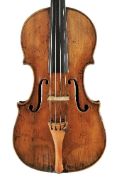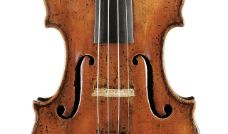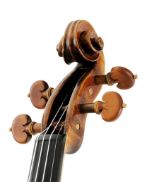Violin, Giovanni Battista Guadagnini, Milan, 1749
Printed label: “Joannes Baptista Guadagnini Pla- / centinus fecit Mediolani 1749.” (49 handwritten)In September 1749, Guadagnini moved from Piacenza to Milan, the capital of Lombardy, which at the time was under Habsburg rule. He lived there until 1758 and perfected his personal style as a luthier during his formative years. Numerous violinmakers operated workshops in Milan in this period. They were well-organized in an efficient guild, but Guadagnini succeeded in holding his own against his competitors. He used the best resonance wood for his instruments and applied a lustrous varnish with intense red hues to many of the instruments he crafted during this period. The 1749 violin is a broad model with a medium-high arch. The annual rings of the divided belly are of medium width, with the rings becoming much broader toward the treble side. The most recent annual ring was dated 1734 in a dendrochronological report. The report also found a very high degree of correspondence with other instruments Guadagnini built during this period, allowing the conclusion that he acquired a large amount of resonance wood from one tree, so that he would have the same quality of wood available to make several instruments. The one-piece, quarter-cut back is unflamed. By contrast, the ribs display broad, regular flaming. The violin has a very full arch that meets the edge almost without fluting. Its purfling is very wide and crafted somewhat irregularly. The f-holes are fairly upright, pleasantly curved, and have large eyes. Thanks to the deeply cut volutes, the scroll looks powerful and very sculptural, but it is also slightly asymmetrical, as the eye on the bass side is somewhat lower than the other eye. Like many of Guadagnini’s instruments, the scroll of this violin displays layout punctures he used to mark the outline before carving. The golden-yellow ground is coated with an intensive, red-brown color varnish that is still abundantly visible on the back around the C-bouts and on the ribs. The varnish profile can be made out distinctly in areas where the varnish has been partly worn away. The violin’s overall condition is very good.






